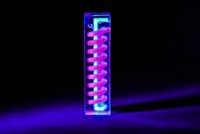Advertisement
Grab your lab coat. Let's get started
Welcome!
Welcome!
Create an account below to get 6 C&EN articles per month, receive newsletters and more - all free.
It seems this is your first time logging in online. Please enter the following information to continue.
As an ACS member you automatically get access to this site. All we need is few more details to create your reading experience.
Not you? Sign in with a different account.
Not you? Sign in with a different account.
ERROR 1
ERROR 1
ERROR 2
ERROR 2
ERROR 2
ERROR 2
ERROR 2
Password and Confirm password must match.
If you have an ACS member number, please enter it here so we can link this account to your membership. (optional)
ERROR 2
ACS values your privacy. By submitting your information, you are gaining access to C&EN and subscribing to our weekly newsletter. We use the information you provide to make your reading experience better, and we will never sell your data to third party members.
Materials
Shrinky Dink Devices
Children's toy simplifies fabrication of molds for microfluidic devices
by Celia Henry Arnaud
November 27, 2007

A new method makes fabricating microfluidic devices almost as easy as child's play. Michelle Khine and her coworkers at the University of California, Merced, and UC Berkeley, use the children's toy Shrinky Dinks to construct molds for microfluidic devices (Lab Chip, DOI: 10.1039/b711622e). Khine and coworkers have used the method to make a functional microfluidics-based gradient generator and are working on other devices.
When Khine, an assistant professor of engineering, arrived at UC Merced a year ago, she didn't have the equipment set up to do standard photolithography, which is currently used to make microfluidic devices. "I'm not a very patient person, so I didn't want to wait around for all the equipment to be set up before my lab got up and running," she says. Playing around in her kitchen at home, she realized that she might be able to make channels by using Shrinky Dinks, which had been her favorite toy as a young child.
Khine's team makes those channels by printing patterns for microfluidic devices on the polystyrene thermoplastic Shrinky Dinks using a standard laser-jet printer. When heated to 163 ??C for three to five minutes, the printed features shrink approximately 63%. At the same time, the height of the features increases fivefold.
The researchers then use the shrunken features as a rigid mold for soft lithography. The shrunken Shrinky Dinks replace commonly used silicon wafer molds, which must be made by photolithographic patterning.
The microfluidic devices Khine and coworkers make have channels as narrow as 65 µm and as deep as 80 µm. The entire fabrication process from design to finished device takes less than half an hour. Khine thinks that the resolution could be improved by using a better printer.
The thermoplastic molds are faster and cheaper to make than are ones made with standard photolithography. Also, Khine can buildup multiple feature heights on the same device by reprinting some channels and not others, whereas different channel heights are time-consuming to create by standard photolithography. And the thermoplastic technique intrinsically creates rounded channels, which are necessary for microfluidic pneumatic valves. Standard photolithographic techniques tend to produce rectilinear features.
The new fabrication method "opens up the microfluidics field to an even wider range of research groups," says Noo Li Jeon, associate professor of biomedical engineering at the UC Irvine. "Anyone with a laser printer can now make microfluidic chips."





Join the conversation
Contact the reporter
Submit a Letter to the Editor for publication
Engage with us on Twitter